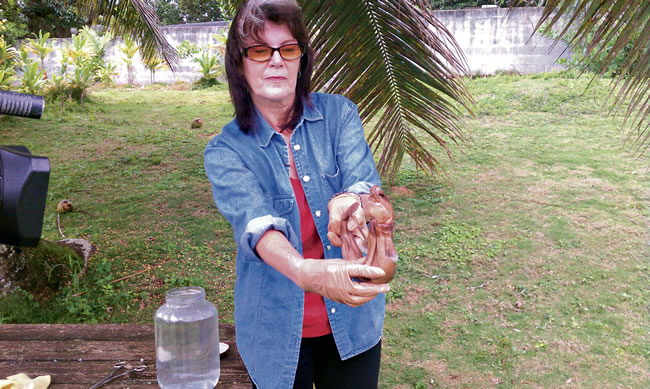Cookie Cutter Shark Fascination
When researchers from Hawaii and Florida confirmed last July that Maui swimmer Michael Spalding was the first documented attack by a cookie cutter shark on a live human, I became obsessed with the mysterious marine life, researching previous attacks and searching endlessly for photographs and video.
A day later I received an email from a friend that took my fascination to an entirely different level. “Ron, I have a cookie cutter shark in a jar. Do you want to see it?”
The message was from Susan Siu, a former investigator at the city medical examiner’s office who has long collected bizarre items. I responded, “Yes! When you’re ready to show it, I’m there!”
I could barely contain myself.
Last week I finally received the call for which I had waited nine months: Siu was ready to share the rare specimen with me. My heart raced when I first saw her carrying the large jar with the mysterious creature floating inside.
I stared in disbelief knowing only a few people have ever seen the deep-sea creature up close.
“Here it is,” she said beaming with pride. It was bigger than I had imagined and it was as ugly as it appeared in pictures on the Internet and YouTube.
I focused on its bulging eye sockets and nasty jaw – the same jaw that is notorious for ripping holes in dolphins, whales and even humans.
Siu worked as an investigator with the medical examiner’s office for nearly 20 years, and several cases are still burned into her memory, including one that involved the death of two people at sea.
“A boat capsized and two of the victims had very unique injuries,” she recalls. “I needed to know, so I called a friend from marine fisheries who knew about marine bites. Immediately I was told this was a cookie cutter shark bite because of the perfectly symmetrical round, wide, deep plug.”
Her friend knew she was a collector of the strange and bizarre and gave her a rare specimen of a cookie cutter. She never asked where it came from.
“He knew I was fascinated with discovering what the wound was and that I could be at peace knowing it wasn’t something other than a cookie
cutter,” says Siu, who emphasized the 2-foot-long shark did not kill the victims. “I was always interested in anything that was not normal, and I believe that’s what led him to me and me to him. He’s been my little pal for the past over 10 years.”
Siu says the case involving Spalding, who was attacked in March of 2009 while attempting to swim across the Alenuihaha Channel, triggered memories of the case she worked on more than a decade ago. She said the circlesized chunk taken out of Spalding’s left calf, which measured about 4 inches wide and an inch-and-a-half deep, was eerily similar to wounds she saw.
“That took me back to my years and that was, I think, the first time I actually heard of a cookie cutter attacking a live human,” says Siu.
Marine scientists say Siu’s specimen is rare and it would be a valuable educational tool, not to mention a great addition to the fish museum at the University of Hawaii-Manoa.
“There are very few in captivity, and I think part of the reason is because they’re usually caught in deep water or they migrate vertically,” says Kathleen Cole of the UH Biology Department. “When I asked her what she was going to do with it, I said do you want to keep it? And she said, oh yes. So if a fisherman ever came across one, we’d be more than delighted to receive it as a donation.”
After chatting for a few minutes, I finally asked if I could hold it. It was much smoother than I thought it would be. In a strange way, I was ecstatic.
“My son absolutely hates it. He said get rid of it; I just can’t part with him,” she laughs. “I’m sure a lot of people would love to have him, but he’s mine until I die. I will put him in my will and then they can have him.”
Hopefully, she might consider giving it to me one day, but a conversation with my wife and children may be necessary first.
rkmizutani@gmail.com
Correction: Because of an editor’s error in the April 25 issue, the paddler in the photo was identified incorrectly. It is Lauren Spalding, the women’s champion, not Jimmy Austin. MidWeek regrets the error.






